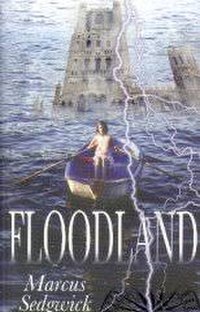"Imagine that England is covered by water, and Norwich is an island ..." begins the cover blurb of Marcus Sedgwick's young-adult novel Floodland (Dolphin Paperbacks / Orion Children's Books, 2000, ISBN 1 85881 763 3).
Floodland is set in a post-apocalyptic East Anglia, largely flooded following sea level rise, tells the story of Zoe Black, a young girl who has been separated from her parents during the evacuation of Norwich. Surviving for a while in the ruins of the city, she finds a rowing boat and escapes to somewhere little better: "Eels Island", where a tribe of starving semi-feral children are squatting in Ely Cathedral. She makes two friends there: a small boy nicknamed Munchkin; and the sole adult, a mildly demented old man called William Blake (who is obsessed with the works of his visionary namesake). Dooby, the vicious but intelligent leader of the Eels tribe, confides in Zoe, explaining that the tribe has no future and that she figures in his plan to escape by boat. However, this plan is scuppered when the Eels are attacked by the Cats and Horses, rival tribes from other islands. In the mayhem Zoe and Munchkin alone escape, rowing westward until they're cast ashore on the mainland at Hope, "a little west of what used to be Cambridge". Looking for Zoe's parents, they hike along the shore and eventually find them at a larger settlement, Newhome.
It's a short novel - 122 pages - and very readable. It brings the whole issue of global warming to a personal level in a recognisable landscape, with a deal of allusory depth. William's ravings conflate his recollections of the Doctor Foster rhyme with various versions of the Flood legend, the works of Blake, and an accurate description of icecap melting; the scenario of Eels Island is also very similar to that of Golding's The Lord of the Flies. I think Floodland quite rightly won the Branford Boase Award in 2001 for an outstanding first published novel, though I'm not sure what most of the intended readership would make of the Blake allusions, such as the Eels (tutored by the Blake character) calling the ocean Udan-Adan and thinking a city called Golgonooza exists. The whole scenario, in fact, is an extended allusion to a Blake work, the clue being Zoe's boat, which is called Lyca. As William mentions, Lyca is the seven-year-old girl in Blake's The Little Girl Lost (from his Songs of Experience) who gets lost, but is cared for by wild animals until reunited with her parents in The Little Girl Found.
If I have a major criticism of Floodland, it's a geeky one: the projected geography is mostly wrong. Although the Fens and Norfolk Broads are low-lying, the majority of East Anglia is actually a quite elevated chalk plateau (Swaffham, for instance, is about 80m above current sea-level). If you use the nice sea level app at flood.firetree.net to try different sea level rises, you find that for any rise that left Ely as an island (try 13m and 20m), East Anglia would still be continuous with the mainland. Nor would Norwich, which is built on a river confluence rather than a hill, ever become an isolated island as depicted in the book. With sea level rise, it would be increasingly dissected as the Yare and Wensum rivers turned into rias (see 30m); and the higher land of East Anglia would persist as an archipelago (see 50m) long after Norwich was submerged.
Addendum: see Not trawling, but drowning at Felix Grant's The Growlery.
- Ray

No comments:
Post a Comment